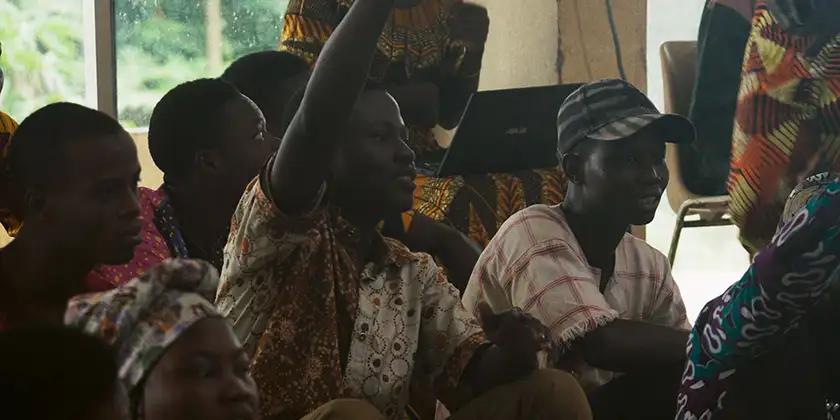With her experimental documentary Dahomey, Mati Diop has created a modest but memorable investigation into the polarising question of cultural heritage restitution.
Director: Mati Diop
Genre: Documentary
Run Time: 68′
TIFF Screening: Sept. 5-14, 2024
Theatrical release Date: October 2024 (US, UK, Latin America, Germany); November 2024 (CA)
MUBI Release date: December 13, 2024
Mati Diop has clearly had a move into documentary filmmaking on her mind for some time. In 2020, the celebrated Atlantics director gave us a taste of what was to come with In My Room, her contribution to the Women’s Tales anthology series. Like that short film, Dahomey sees the gifted narrative filmmaker apply a touch of experimentalism to this new filmic frontier. At just 67 minutes long, Dahomey may appear unassuming, but the issues it examines in that brief runtime have sweeping implications.
The film concerns the return of 26 Beninese artefacts to their homeland after a nearly 130-year wait. These treasures had previously been housed in the museums of France, but changing times and important, still ongoing conversations have led to a long-overdue restitution.
The format of the film is one of its most interesting aspects. First we hear the narration of King Gezo of Dahomey, the kingdom that existed before annexation by France in 1904; his statue is one of the items being repatriated. In a film about previously silenced voices finally being heard, the presence of Gezo is a stroke of experimental genius from Diop. But is it Gezo himself speaking to us, or the statue? And how might this distinction change the significance of his words?
Punctuated by observations from this spectral narrator, the documentary is essentially split into two parts, the first following the unexciting process of packaging and delivering the artefacts. Seeing these precious monuments of such historical and cultural significance presented in this matter-of-fact way is a strange experience, though all the handling, wrapping and drilling becomes oddly mesmerising. The most surprisingly compelling moment comes when the box carrying Gezo is sealed shut, leaving the camera, and thus the audience, in there with him. Diop lets the scene run for longer than you’d expect, forcing us to bask in the darkness and silence before the king’s voice returns to speak to us again.

Once the items have made it to their true home, the process of evaluating and displaying them, and debating their significance, begins. The inclusion of a Beninese campus debate wisely reminds us that no group is a monolith; in a country of over 13 million people, there’s going to be a diversity of opinions on what this restitution really means. Some see the move as a victory, others consider it an insult that just 26 of the thousands of items stolen by the French have made it back. There’s also much debate over their future: while most view the objects as works of art, one voice proclaims that they are religious relics and should be treated as such, not placed in glass boxes for tourists to observe.
By presenting and engaging with these questions, Diop elevates Dahomey from a fly-on-the-wall film to an active participant in a discourse currently engulfing the arts and heritage world. That it manages to also be an impressive work of creative invention itself is a testament to Diop’s artistry, as is her seemingly effortless transition from narrative cinema to documentary. This small but mighty dialectic is as good a representation as any of the importance of this conversation to society’s present state, and, like the objects whose journeys it documents, may well be considered a valuable artefact of our time in years to come.
Dahomey was screened at TIFF on September 5-14, 2024 and released in theaters in the US, UK, Latin America, Germany and more from October 2024, and in Canada from November. The film will be available to stream on Mubi from December 13, 2024. Read our review of The Woman King!

